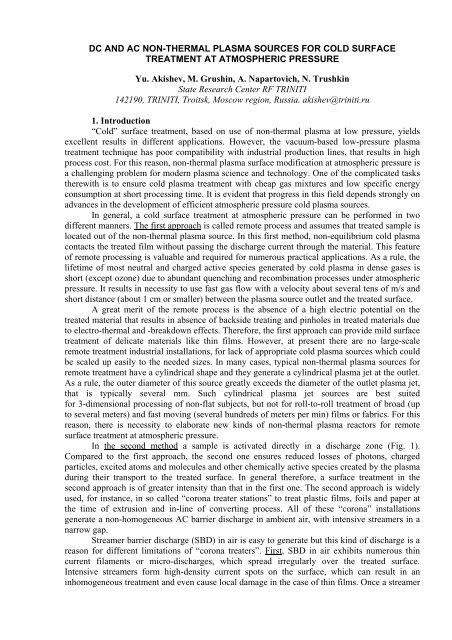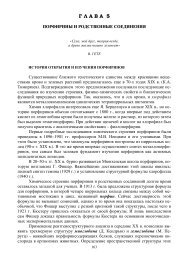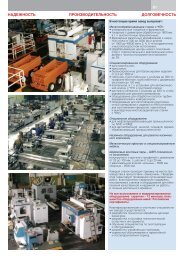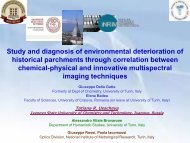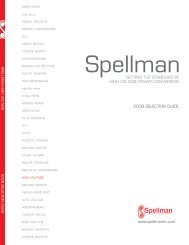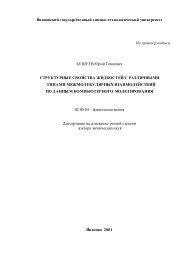DC AND AC NON-THERMAL PLASMA SOURCES FOR COLD ...
DC AND AC NON-THERMAL PLASMA SOURCES FOR COLD ...
DC AND AC NON-THERMAL PLASMA SOURCES FOR COLD ...
Create successful ePaper yourself
Turn your PDF publications into a flip-book with our unique Google optimized e-Paper software.
<strong>DC</strong> <strong>AND</strong> <strong>AC</strong> <strong>NON</strong>-<strong>THERMAL</strong> <strong>PLASMA</strong> <strong>SOURCES</strong> <strong>FOR</strong> <strong>COLD</strong> SURF<strong>AC</strong>E<br />
TREATMENT AT ATMOSPHERIC PRESSURE<br />
Yu. Akishev, M. Grushin, A. Napartovich, N. Trushkin<br />
State Research Center RF TRINITI<br />
142190, TRINITI, Troitsk, Moscow region, Russia. akishev@triniti.ru<br />
1. Introduction<br />
“Cold” surface treatment, based on use of non-thermal plasma at low pressure, yields<br />
excellent results in different applications. However, the vacuum-based low-pressure plasma<br />
treatment technique has poor compatibility with industrial production lines, that results in high<br />
process cost. For this reason, non-thermal plasma surface modification at atmospheric pressure is<br />
a challenging problem for modern plasma science and technology. One of the complicated tasks<br />
therewith is to ensure cold plasma treatment with cheap gas mixtures and low specific energy<br />
consumption at short processing time. It is evident that progress in this field depends strongly on<br />
advances in the development of efficient atmospheric pressure cold plasma sources.<br />
In general, a cold surface treatment at atmospheric pressure can be performed in two<br />
different manners. The first approach is called remote process and assumes that treated sample is<br />
located out of the non-thermal plasma source. In this first method, non-equilibrium cold plasma<br />
contacts the treated film without passing the discharge current through the material. This feature<br />
of remote processing is valuable and required for numerous practical applications. As a rule, the<br />
lifetime of most neutral and charged active species generated by cold plasma in dense gases is<br />
short (except ozone) due to abundant quenching and recombination processes under atmospheric<br />
pressure. It results in necessity to use fast gas flow with a velocity about several tens of m/s and<br />
short distance (about 1 cm or smaller) between the plasma source outlet and the treated surface.<br />
A great merit of the remote process is the absence of a high electric potential on the<br />
treated material that results in absence of backside treating and pinholes in treated materials due<br />
to electro-thermal and -breakdown effects. Therefore, the first approach can provide mild surface<br />
treatment of delicate materials like thin films. However, at present there are no large-scale<br />
remote treatment industrial installations, for lack of appropriate cold plasma sources which could<br />
be scaled up easily to the needed sizes. In many cases, typical non-thermal plasma sources for<br />
remote treatment have a cylindrical shape and they generate a cylindrical plasma jet at the outlet.<br />
As a rule, the outer diameter of this source greatly exceeds the diameter of the outlet plasma jet,<br />
that is typically several mm. Such cylindrical plasma jet sources are best suited<br />
for 3-dimensional processing of non-flat subjects, but not for roll-to-roll treatment of broad (up<br />
to several meters) and fast moving (several hundreds of meters per min) films or fabrics. For this<br />
reason, there is necessity to elaborate new kinds of non-thermal plasma reactors for remote<br />
surface treatment at atmospheric pressure.<br />
In the second method a sample is activated directly in a discharge zone (Fig. 1).<br />
Compared to the first approach, the second one ensures reduced losses of photons, charged<br />
particles, excited atoms and molecules and other chemically active species created by the plasma<br />
during their transport to the treated surface. In general therefore, a surface treatment in the<br />
second approach is of greater intensity than that in the first one. The second approach is widely<br />
used, for instance, in so called “corona treater stations” to treat plastic films, foils and paper at<br />
the time of extrusion and in-line of converting process. All of these “corona” installations<br />
generate a non-homogeneous <strong>AC</strong> barrier discharge in ambient air, with intensive streamers in a<br />
narrow gap.<br />
Streamer barrier discharge (SBD) in air is easy to generate but this kind of discharge is a<br />
reason for different limitations of “corona treaters”. First, SBD in air exhibits numerous thin<br />
current filaments or micro-discharges, which spread irregularly over the treated surface.<br />
Intensive streamers form high-density current spots on the surface, which can result in an<br />
inhomogeneous treatment and even cause local damage in the case of thin films. Once a streamer
strikes the polymer surface, it leaves a local distortion, which in turn attracts the next streamer to<br />
the exactly same spot. Second, to initiate SBD in air, high voltage is required. This voltage can<br />
be high enough to induce a discharge on the back side of fast-moving webs, resulting in<br />
treatment of this back surface as well, an effect not desired in most cases. Third, to ensure high<br />
level of both the line speed of treatment and the energy dose per cm 2 of treated surface, it is<br />
necessary to enhance drastically the average power density of SBD, but this results in a great<br />
problem of thermal expansion of the electrodes. Fourth, “corona treaters” working with air<br />
generate a lot of ozone. All parts utilized in the treater stations therefore have to be made of<br />
corrosion- and ozone-proof materials, and equipped with a ventilator and filter system to<br />
eliminate ozone, which results in increase of cost of the “corona treaters”.<br />
Hence, in spite of the existence of a broad spectrum of industrial “corona treaters” based<br />
on SBD in air, there is a need to offer other approaches for cold treatment using both new types<br />
of the plasma gases and <strong>AC</strong> discharges at atmospheric pressure. One of the attractive ways is to<br />
utilize electropositive gases like He, Ar, N 2 , which do not produce harmful ozone and require<br />
lower voltage to sustain the <strong>AC</strong> discharge than that in air under the same operating conditions.<br />
To obtain a high line speed, a reasonable operating cost and acceptable quality of materials<br />
treated with <strong>AC</strong> discharges, it is reasonable to use metallic or resistive sharpened electrodes<br />
typical for true corona operation (Fig. 1b). In general, an electrode system with a sharpened<br />
electrode generates an <strong>AC</strong> discharge that combines properties of both barrier discharge and <strong>AC</strong><br />
corona, which can therefore be named “<strong>AC</strong> barrier corona” (<strong>AC</strong>BC). The sharpened electrodes<br />
possess a strong electric field around them and provoke the formation of streamers under lower<br />
voltage across the inter-electrode gap than that in a classical barrier discharge. It follows that<br />
volume streamers in <strong>AC</strong>BC are weaker than those are in a barrier discharge between plane<br />
electrodes. Because of the lower voltage, one would expect that the sliding surface streamers in<br />
<strong>AC</strong>BC will be also weaker, and the local influence of mild surface streamers on the treated<br />
substrate will be of lower intensity than that in a barrier discharge generated with smooth<br />
electrodes. This circumstance can help avoid local damage of thin dielectric materials during<br />
cold plasma treatment.<br />
We offer a new kind of atmospheric pressure plasma surface treater based on <strong>AC</strong>BC.<br />
This discharge is generated with sharpened electrodes which can produce <strong>AC</strong>BC with mild<br />
sliding surface streamers. A set of experiments with <strong>AC</strong>BC in ambient air and Ar at atmospheric<br />
pressure were carried out separately, and the gas-discharge conditions that correspond to strong<br />
increase in wettability of polymer films and fabrics after short cold plasma treatment have been<br />
investigated. We have succeeded also in developing a steady-state diffusive glow discharge in<br />
fast air flow at atmospheric pressure. This discharge can serve as the basis of a non-thermal<br />
plasma reactor for remote cold surface treatment, in particular, for fast roll-to-roll processing of<br />
wide films and fabrics. Atmospheric pressure glow discharge is easily scaled up transverse to the<br />
gas flow direction, to the extent needed for specific applications. This discharge has been applied<br />
to the remote surface treatment of polyethylene films and polyester fabrics.<br />
2. Setup of <strong>DC</strong> atmospheric pressure glow discharge<br />
A general scheme of our lab-scale plasma reactor based on <strong>DC</strong> volume diffusive glow<br />
discharge is depicted in Fig. 2. This source produces many chemically active species without<br />
significantly heating the background gas flow. A steady-state diffusive glow discharge is<br />
sustained by rectified high voltage (up to 30 kV), which is applied to the multi-pin cathode and<br />
plane anode, separated by a gap h about of 1 cm (Fig. 2). The distance between sharpened pins<br />
equals 3.5 mm. The pins were fabricated from stainless steel with a diameter of 1 mm. Each<br />
cathode pin is ballasted with a resistor of 1 MΩ. The electrodes are placed in a dielectric channel<br />
with a high flow of air. The exit cross-section h x l of the plasma source is 1.0 x (5-20) cm 2 . In<br />
our case, the width l of the discharge zone transverse to the gas flow was varied from 5 to 20 cm;<br />
in principle, l can be increased as much as needed, up to the size of industrial installations for<br />
remote surface treatment. The length of the discharge chamber along the flow direction is short,<br />
not exceeding several centimeters.
Our gas discharge installation is specially equipped with a setup which allows pre-heating<br />
the background gas entering the plasma source to 65 °C, and varying the water vapor<br />
concentration in the process gas between 1.5 and 10 vol %. The gas velocity through the plasma<br />
source ranges from 0 up to 55 m/s. The high gas velocity limits losses of chemically active<br />
particles on their way to the surface, and thus intensifies the treatment.<br />
The setup used allows a dynamic regime of remote treatment, which simulates some<br />
aspects of an industrial roll-to-roll process. A polymer sample of 10 cm length is placed on the<br />
surface of the 36 cm diameter cylinder. As a rule, the distance between the discharge chamber<br />
and cylinder surface was 10 mm.<br />
3. Setup of <strong>AC</strong> barrier corona (<strong>AC</strong>BC) at atmospheric pressure<br />
The multi-pin <strong>AC</strong>BC was created within a dielectric chamber (cylinder 160 mm in inner<br />
diameter and 150 mm in length) between the multi-pin sharpened electrode and the plane<br />
metallic electrode, the latter being covered with dielectric material to be treated. The electrical<br />
scheme of this discharge is identical to that presented in Fig. 1b. The diameter of the metallic<br />
plate was 100 mm. The radii of the pin tips are 100 µm. The distance between the plane and<br />
sharpened electrodes was varied up to 35 mm. The number of pins depends on the type of<br />
plasma-producing gas and overall area under treatment. This electrode system is easily scaled up.<br />
We used two power supplies; the first has a fixed frequency, 50 Hz, and voltage<br />
amplitude up to 35 kV. This power supply was used for excitation of <strong>AC</strong>BC in ambient air. The<br />
amplitude and frequency of the second power supply could be varied up to 4.5 kV, and from 50<br />
to 10 5 Hz, respectively. The latter power supply was used for excitation of <strong>AC</strong>BC in Ar.<br />
Experiments on treatment of polymer materials with <strong>AC</strong>BC were performed using of the<br />
described setup, the samples being static during treatment. Exposure time was varied with a<br />
programmable timer switching on/off the <strong>AC</strong> high-voltage generator.<br />
4. Properties of steady-state glow discharge in fast air flow<br />
The relation between the applied voltage U and the reduced current I is termed the Volt-<br />
Ampere Characteristics (V<strong>AC</strong>) of a discharge. A typical V<strong>AC</strong> of a steady-state multi-pin <strong>DC</strong><br />
discharge in a fast air flow is presented in Fig. 3. Because the sharpened electrode system is<br />
close to pin-plane corona geometry, the initial region of the V<strong>AC</strong> (small currents and large<br />
increase in applied voltage) corresponds to the well-known corona with dark inter-electrode gap.<br />
The region of slow rising voltage corresponds to a new current regime named diffusive glow<br />
discharge, which is accompanied by intense light emission from the entire gap.<br />
The fast gas flow prevents the formation of sparks. There is another crucial parameter<br />
that drastically influences the efficiency of producing chemically active species in the glow<br />
discharge, namely the absolute humidity of the background gas flow, that is, the concentration of<br />
water vapor in the process gas. The humidity impacts the average reduced electric field E/P. The<br />
appropriate experimental data are presented in Fig. 4.<br />
The average reduced electric field E/P is a very important discharge parameter,<br />
determining the average kinetic energy of electrons T e in discharge plasma. The higher E/P, the<br />
higher T e , and therefore the higher (exponentially) is the efficiency of electrons in dissociation<br />
and excitation of background molecules like O 2 and H 2 O, from which the chemically active<br />
species like O and OH radicals are formed. One can say, therefore, that operation of a glow<br />
discharge under high humidity (in another words, at high E/P and low currents) is energyefficient.<br />
Besides, energy losses due to voltage drop across the cathode ballast resistors decreases<br />
as well, because of the lower discharge current in moist air. Additionally, the very low<br />
concentration of harmful ozone can provide environmental friendly operation without the need<br />
for expensive elimination of ozone.<br />
5. Properties of <strong>AC</strong> barrier corona<br />
Air. An <strong>AC</strong> discharge in air requires a higher voltage (more than tenfold) to sustain than<br />
that in Ar. The <strong>AC</strong> barrier corona appears almost homogeneous in the gas gap and above the<br />
surface of a dielectric film. In fact, <strong>AC</strong>BC in air has two different current modes, depending on
positive or negative polarity of the applied voltage. These modes clearly reveal themselves in the<br />
waveform of the <strong>AC</strong> discharge current, representative examples of current and voltage<br />
oscillograms being presented in Fig. 5.<br />
During the positive half-period, <strong>AC</strong>BC is non-uniform because it operates under a<br />
streamer regime. Each streamer strikes the surface and branches over it in the form of short<br />
sliding streamers. The streamer length in the bulk of the gap is much greater than those on the<br />
surface<br />
The negative half-period of <strong>AC</strong>BC corresponds to a homogeneous glow regime without<br />
any spikes in the current oscillogram. There are two reasons why streamers are absent during the<br />
<strong>AC</strong>BC negative half-period. First, pins do not provoke streamers in a negative corona, and<br />
second, the uniform anode region formed near the dielectric film is highly tolerant to streamer<br />
initiation as well.<br />
Argon. In comparison with air, Ar is an easily ionized gas. This results in strong<br />
differences in discharge properties between <strong>AC</strong>BC in air and Ar. There is a critical power<br />
frequency, f cr (about 10 kHz), which separates two different current regimes of <strong>AC</strong>BC in Ar.<br />
The cross-section of higher frequency barrier corona (HFBC) generated with a single<br />
sharpened electrode is smaller than that in air, and it practically remains unchanged with varying<br />
applied voltage. Serious problem with <strong>AC</strong>BC in Ar at higher frequency is that it is difficult to<br />
uniformly distribute the total current of the HFBC over the multi-pin electrode system.<br />
Consequently, the average current density at the polymer substrate is too high, and it can damage<br />
a thin film due to thermal effects.<br />
The current waveform in lower frequency barrier corona (LFBC) (Fig. 6) has almost<br />
symmetrical shape, with many sharp current spikes in each half-period. It means that streamers<br />
occur in LFBC during both positive and negative half-periods. Our observations show that the<br />
length of sliding surface streamers in LFBC in Ar are much greater than the length of volume<br />
streamers, that is, LFBC in Ar spreads over a surface very readily. This is a distinctive property<br />
of <strong>AC</strong>BC in Ar, which is extremely important for surface treatment. The effective diameter<br />
occupied by mild surface streamers is nearly 10 cm at f=50 Hz and U=3 kV. To the naked eye,<br />
this area looks like a dense web of many thin, faint whitish filaments running chaotically and<br />
rapidly over the polymer film. In contrast to low frequency barrier corona in air, the crosssection<br />
of surface streamer area in LFBC in Ar does not depend on, h, the length of interelectrode<br />
gap; the effective diameter of LFBC in Ar increases with amplitude and decreases with<br />
frequency powering the <strong>AC</strong>BC.<br />
6. Results of atmospheric pressure “cold” treatment<br />
These results will be demonstrated at oral presentation of the report.<br />
7. Conclusions<br />
<strong>DC</strong> glow discharge remote treatment with high line speed, up to 500-600 m/min (similar<br />
to a roll-to-roll regime) appears possible. Such rapid processing can be realized with an attractive<br />
linear power density of about 20 W/cm, which is 2 to 2.5 times lower than that in large-scale<br />
industrial <strong>AC</strong> “corona” treaters at the same line speed.<br />
Low frequency barrier corona in atmospheric pressure argon induces many mild surface<br />
streamers, which readily slide over a large area of the treated substrate. This regime of <strong>AC</strong>BC is<br />
energetically favorable, and provides gentle treatment of substrates at a low level of the reduced<br />
power density, about 0.1 W/cm 2 , without damage to a thin polymer film. <strong>AC</strong>BC in argon is<br />
powered with a much smaller (by a factor of 10) amplitude of the applied voltage, in comparison<br />
with a barrier discharge in air. This low voltage reduces the danger of back side treatment,<br />
usually highly undesirable.<br />
Cold plasma processing with <strong>AC</strong>BC in Ar creates a long-lasting treatment effect at low<br />
energy dose, and this attribute of streamer processing in Ar makes it attractive from a practical<br />
application point of view. Lastly, a comparison between <strong>AC</strong>BC in Ar and <strong>AC</strong>BC in N 2 , He<br />
shows that LFBC in Ar provides a better treatment effect at lower consumed energy.
8. Figures<br />
1<br />
4<br />
3<br />
2<br />
1<br />
a) b)<br />
Fig. 1. Schematics of cold plasma treatment in<br />
the discharge zone: a) classical barrier discharge;<br />
b) <strong>AC</strong> barrier discharge with sharpened<br />
electrode(s). 1: metallic electrode; 2: treated<br />
film; 3: streamers; 4: barrier.<br />
Fig. 2. Sketch of a multi-pin electrode system<br />
used for generating a volume diffusive glow<br />
discharge in air flow at atmospheric pressure.<br />
23<br />
21<br />
Voltage, U (kV)<br />
19<br />
17<br />
15<br />
background<br />
gas parameters:<br />
P = 744 Torr<br />
V = 55 m/s<br />
h = 12 mm<br />
humidity = 2.7 Vol %<br />
T = 25 o C<br />
13<br />
0,0 0,5 1,0 1,5 2,0<br />
current, I (mA/cm)<br />
Fig. 3. Volt-Ampere Characteristic for reduced<br />
current per 1 cm in transverse direction of a<br />
multi-pin steady-state diffusive discharge in fast<br />
air flow.<br />
Fig. 4. Impact of air flow humidity on<br />
average reduced electric field, E/P, in the<br />
bulk of the glow discharge.<br />
Fig. 5. Typical voltage (above) and current<br />
oscillograms of <strong>AC</strong>BC in air with sharpened<br />
electrode and barrier of PE-film. Power<br />
frequency is 50 Hz. Time scale is 5 ms/div.<br />
Voltage amplitude is 32 kV.<br />
Fig. 6. Typical voltage (above) and current<br />
oscillograms of <strong>AC</strong>BC in Ar with sharpened<br />
electrode and barrier of PE-film. Power<br />
frequency is 400 Hz. Time scale is 1 ms/div.<br />
Voltage amplitude is 3.2 kV.


